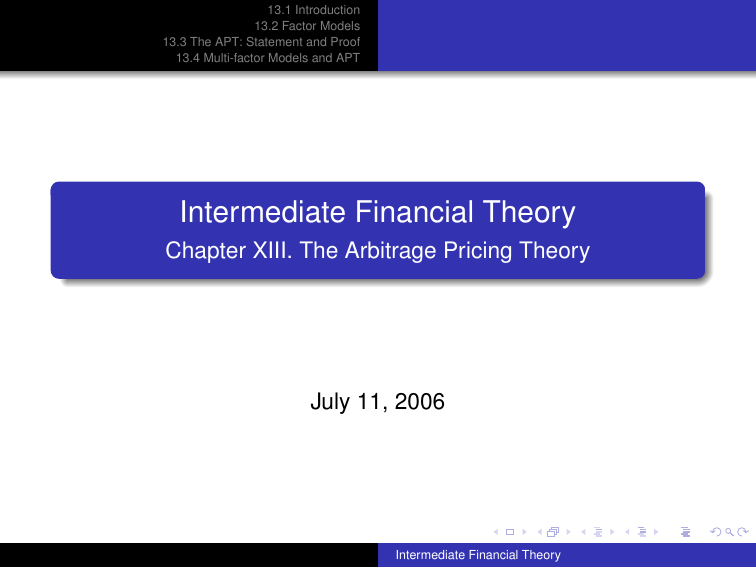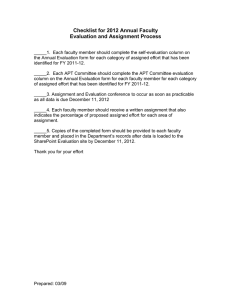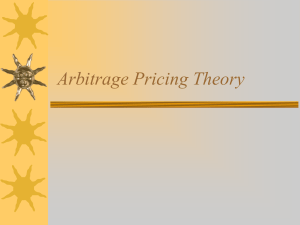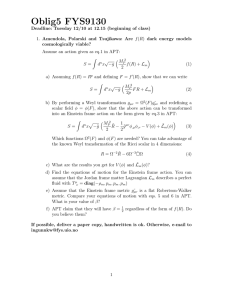Intermediate Financial Theory - Chapter XIII. The Arbitrage Pricing
advertisement

13.1 Introduction 13.2 Factor Models 13.3 The APT: Statement and Proof 13.4 Multi-factor Models and APT Intermediate Financial Theory Chapter XIII. The Arbitrage Pricing Theory July 11, 2006 Intermediate Financial Theory 13.1 Introduction 13.2 Factor Models 13.3 The APT: Statement and Proof 13.4 Multi-factor Models and APT 13.1 Introduction Equilibrium vs. No Arbitrage At equilibrium there can be no arbitrage Usefulness of A-D prices depend on no arbitrage hypothesis APT: parallel with A-D pricing Doing away with states of nature Replaced by the concept of risk factor Primitive security = security whose risk is exclusively determined by its association with one specific factor, totally immune form association with other risk factors Intermediate Financial Theory 13.1 Introduction 13.2 Factor Models 13.3 The APT: Statement and Proof 13.4 Multi-factor Models and APT 13.2 Factor Models r̃j = αj + βj r̃M + ε̃j , (1) E ε̃j = 0, cõv r̃M ,ε̃j = 0, ∀j, and cov ε̃j ,ε̃k = 0, ∀j 6= k All return characteristics common to different assets are subsumed in their link with the market. APT: many, ex ante unidentified factors. Intermediate Financial Theory 13.1 Introduction 13.2 Factor Models 13.3 The APT: Statement and Proof 13.4 Multi-factor Models and APT A Quasi-Complete Market Hypothesis Property 1 N X xi = 0 = x T ·1, i=1 Property 2 N X xi βi = 0 = x T · β. i Property 2 N X 2 xi2 σ εi ∼ = 0. i Intermediate Financial Theory 13.1 Introduction 13.2 Factor Models 13.3 The APT: Statement and Proof 13.4 Multi-factor Models and APT Proof of ATP rP = 0 = x T ·r (2) r = λ0 · 1 + λ1 β, or ri = λ0 + λ1 βi for all assets i (3) Geometric representation: x orthogonal to 1 and β x b 1 Intermediate Financial Theory 13.1 Introduction 13.2 Factor Models 13.3 The APT: Statement and Proof 13.4 Multi-factor Models and APT Meaning of λ0 and λ1 r̄f = rf = λ0 . r̄Q = rf + λ1 · 1 r̄i = rf + βi (r̄Q −rf ) . r̄i = rf + βi (r̄M −rf ) . Intermediate Financial Theory (4) 13.1 Introduction 13.2 Factor Models 13.3 The APT: Statement and Proof 13.4 Multi-factor Models and APT r̃j = aj + bj1 F̃1 + bj2 F̃2 + ẽj with E ẽj = 0, cov F̃1 , ε̃j = cov F̃2 , ε̃j = 0, ∀j, and cov ε̃j ,ε̃k = 0, ∀j 6= k . r j = λ0 + λ1 bj1 + λ2 bj2 . λ0 = rf λ 1 = r P1 − r f λ 2 = r P2 − r f Intermediate Financial Theory (5) 13.1 Introduction 13.2 Factor Models 13.3 The APT: Statement and Proof 13.4 Multi-factor Models and APT Let us illustrate. In our two-factor examples, a security j with, say, bj1 = 0.8 and bj2 = 0.4 is like a portfolio with proportions of 0.8 of the pure portfolio P1 , 0.4 of pure portfolio P2 , and consequently proportion −0.2 in the riskless asset. By our usual (no-arbitrage) argument, the expected rate of return on that security must be: rj = −0.2rf + 0.8r P1 + 0.4r P2 = −0.2rf + 0.8rf + 0.4rf + 0.8 r P1 − rf + 0.4 r P2 − rf = rf + 0.8 r P1 − rf + 0.4 r P2 − rf = λ0 + bj1 λ1 + bj2 λ2 Intermediate Financial Theory 13.1 Introduction 13.2 Factor Models 13.3 The APT: Statement and Proof 13.4 Multi-factor Models and APT Advantage of the APT for the portfolio selection Helps identify the sources of risk/split the systematic risks into more detailed components and thus permits modulating one’s risk exposure E.g. two stocks with same beta could have different sensitivities to specific risk factors; useful in managing risk exposure or helping refine conditional expectations on returns. Intermediate Financial Theory



